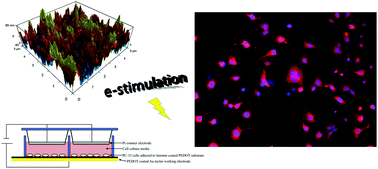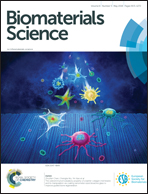PEDOT doped with algal, mammalian and synthetic dopants: polymer properties, protein and cell interactions, and influence of electrical stimulation on neuronal cell differentiation
Abstract
Poly(3,4-ethylenedioxythiophene) (PEDOT) films were electrochemically polymerised with several synthetic (dodecylbenzosulfonic acid (DBSA)) and biological (dextran sulphate (DS), chondroitin sulphate (CS), alginic acid (ALG) and ulvan (ULV)) dopant anions, and their physical, mechanical and electrochemical properties characterised. PEDOT films incorporating the biological dopants ALG and ULV produced films of the greatest surface roughness (46 ± 5.1 and 31 ± 1.9 nm, respectively), and demonstrated significantly lower shear modulus values relative to all other PEDOT films (2.1 ± 0.1 and 1.2 ± 0.2 MPa, respectively). Quartz crystal microgravimetry was used to study the adsorption of the important extracellular matrix protein fibronectin, revealing protein adsorption to be greatest on PEDOT doped with DS, followed by DBSA, ULV, CS and ALG. Electrical stimulation experiments applying a pulsed current using a biphasic waveform (250 Hz) were undertaken using PEDOT doped with either DBSA or ULV. Electrical stimulation had a significant influence on cell morphology and cell differentiation for PEDOT films with either dopant incorporated, with the degree of branching per cell increased by 10.5× on PEDOT-DBSA and 6.5× on PEDOT-ULV relative to unstimulated cells, and mean neurite length per cell increasing 2.6× and 2.2× on stimulated vs. unstimulated PEDOT-DBSA and PEDOT-ULV, respectively. We demonstrate the cytocompatibility of synthetic and biologically doped PEDOT biomaterials, including the new algal derived polysaccharide dopant ulvan, which, along with DBSA doped PEDOT, is shown to significantly enhance the differentiation of PC12 neuronal cells under electrical stimulation.



 Please wait while we load your content...
Please wait while we load your content...